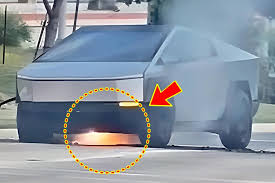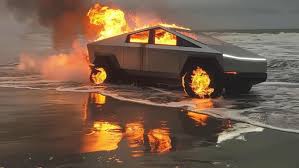The Green carbon reduction idea of using EV vehicles is the world’s biggest lie. Here is why:
- It takes mining half a ton of earth to make a EV battery.
- They are using child slave labor for the mining of lithium.
- The lithium mines are poisoning the rivers and lakes drinking water killing everything.
- EV vehicles can not come in contact with water, and if they do the batteries shut down and catch on fire and you can not open the doors or windows to get out.
- The average driving distance of a EV car is around 250 miles of driving.
- The average time to charge an EV car is 10 to 15 hours only to around 80% charging capacity!
- You are charging your EV car with electricity from nuclear power or worse, coal power plants.
- With 98% of American roads lacking EV charging stations, drivers are limited to staying at home or driving short distances in and around cities only.
- Recycling EV car and pickup truck batteries is 1,000 worse than regular gasoline car batteries.
- EV semi-trailers, as shown by Tesla, are not allowed to drive on American or European roads because they are too heavy for all the bridges and roads worldwide.
- Furthermore, EV semi-trailers take around 20 hours to charge and can only drive 400 to 600 miles, whereas diesel semi-trailers can drive 1,400 miles on diesel and weigh much less than EV semis.
It is shocking how badly designed these EV vehicles are. Just because mankind has taken an idea that was first thought of in 1890 (the first EV car) and recycled that idea to all the Teslas and Fords and GMC’s that is “electric” today, does not mean it is a good idea. It takes 1/2 ton of earth moving to produce one lithium-ion battery car. That in itself should have the tree huggers go nuts. But somehow they overlook this fact.
During the 2024 hurricane events in Florida and the South East US, most house fires were caused by EV vehicles that flooded, and the batteries would short out and catch the whole house on fire. If you talk to any fireman from anywhere worldwide, they would tell you it is impossible to extinguish an EV car fire. Makes you wonder if all these EV owners are considering safety when loading their spouses and kids in an EV car and hitting the road. You drive through a puddle, and in split seconds your car is engulfed in flames. Who do you save???






Electric vehicles (EVs) can pose several dangers, including:
Battery fires
Lithium-ion batteries in EVs can explode and burn for a long time. This can be caused by thermal runaway, a chain reaction that occurs when a cell short-circuits and releases flammable electrolyte. Battery fires can emit toxic and flammable gases, including hydrogen fluoride and hydrogen chloride.
Crash damage
EVs are heavier than gas-powered cars, which can increase crash damage by up to 50%. This is especially dangerous for other drivers.
Electrocution
Exposed electrical components, wires, and high-voltage batteries can cause high-voltage shock hazards.
Environmental impact
EV fires can release aerosol and gaseous emissions, including cancer-causing agents.
Fire suppression
Methods used to control fires in gas-powered cars may not be effective for EVs. It can take several hours to put out the flames and cool the battery.
Reporters from The Howard Center for Investigative Journalism
SILVER PEAK, N.V. – Nyle Pennington, a veteran water scientist who tracks groundwater for local governments, stopped at a monitoring station just one mile from America’s only active commercial lithium mine. For years this well in Central Nevada typically held enough fresh water to reach the height of a three-story building, or about 30 feet. Pennington said it supplied much-needed nourishment for local cattle grazing under the Nevada sun.
On this crisp fall day in October, Pennington dropped a small rock down the well. Pings and clangs rang out as the rock hit bottom. A soft thud echoed back. “Bone dry,” he said. “If that would have had water in it, you would have heard a pronounced, loud splash.”
Pennington, hired by the Central Nevada Regional Water Authority to monitor groundwater levels, has documented a disturbing pattern: underground water sources are dwindling and even disappearing altogether near the Silver Peak lithium mine, which records show has pumped nearly four billion gallons of water from underground every year since 2020. The Silver Peak mine denied it is impacting freshwater aquifers, but Pennington said the evidence he recorded shows otherwise.
Silver Peak, which began mining lithium in the 1960s, won’t remain the only U.S. lithium mine for long. The Howard Center for Investigative Journalism at Arizona State University has documented a surge of proposals to open new lithium mines that will, like Silver Peak, need billions of gallons of water to operate at a time when much of America’s West is still emerging from a recent megadrought.
As part of a Biden administration push to “build America’s electric future,” U.S. officials are encouraging the domestic expansion of lithium mines by dangling federal incentives. The effort would decrease U.S. reliance on China, which controls most of the U.S. supply chain for the lithium, a crucial mineral needed to power computers and military night-vision goggles.
The Howard Center launched a comprehensive, national investigation of the impact the proposed new lithium mines may have on U.S. water supplies. Reporters reviewed tens of thousands of pages of state and federal environmental impact statements and mining operation reports filed by companies involved in every proposed lithium project in the U.S. that sought permits or reached the physical exploration phase by the end of December 2023.
Among the investigation’s key findings:
- There are no federal rules governing how much water any type of mine can consume.
- America’s only operating commercial lithium mine is responsible for drying up nearby monitoring wells, according to reports from Nevada’s largest water authority.
- The vast majority of proposed lithium projects responding to calls for increased supplies of domestic lithium are, in fact, owned by foreign companies or their subsidiaries.
- The majority of proposed lithium projects in the U.S. intend to take water from already stressed sources like the Colorado River or strained groundwater systems.
- Federal authority to stop mines from extracting minerals, even from public land, is weak. The Department of the Interior, in more than 20 years, has not rejected a mining permit due to the harm a mine could cause.
- The federal government approved plans for a future lithium mine, even after its operators disclosed it would create 272 million metric tons of ‘tailings’ containing toxic waste.
Source: https://ictnews.org/news/lithium-minings-untold-threat-to-water
EV Industry Headlines
Ford issues EV industry warning!!!
Ford warns EV owners to stop using Tesla Supercharger adapters due to potential charging issues
The automaker has not disclosed the specific nature of the problem but has emphasized that prolonged use of the faulty adapters could lead to slower charging.
Earnings before interest and taxes (EBIT) for Ford Model e in the first quarter checked in with a $1.32 billion loss. A source told Bloomberg recently that Ford’s losses per EV topped a staggering $100,000 during the first quarter, which was reportedly more than double the loss per EV last year. Jun 18, 2024
With Transforming your EV or gas/diesel engine to a Theron Technologies permanent magnetic turbine generator engine, you have permanent power and never have to refuel or charge again.






